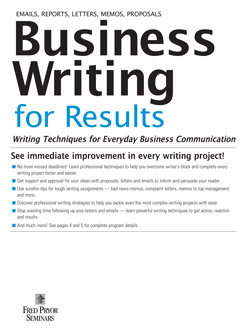Achieve results quickly with business writing training designed to elevate every document you create. Whether you're writing emails, proposals or complex reports, this program delivers the tools you need to write with confidence and clarity.
Eliminate delays and missed deadlines by learning how to overcome writer’s block and complete projects more efficiently. Master professional writing skills that help you organize ideas, clarify your message and communicate with purpose.
Gain the approval and support your ideas deserve. Discover how to craft proposals, letters and memos that inform your audience and persuade decision-makers.
Handle difficult messages with professionalism. Learn proven approaches for writing sensitive content including bad news memos, complaint responses and communications directed to senior leadership.
Unleash the power of AI when creativity stalls. Use AI tools to generate first drafts, streamline your writing process and spark fresh ideas fast.
You don’t need to be a born writer to succeed. Forget the myth that writing is a rare talent. With the right training, anyone can gain the writing skills professionals use every day to produce clear and compelling content.
This seminar breaks down the writing process into practical steps. You’ll focus on real-world applications, not outdated grammar rules. Walk away with a solid foundation in effective business writing that helps you write faster, smarter and with greater impact.
